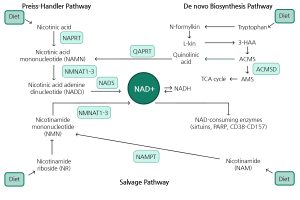NICOTINAMIDE
Nicotinamide, also known as niacinamide, is the active form of Vitamin B3 or niacin. It is a critical component of our body’s defense system and has been proven to help prevent skin cancer and possibly other forms of cancers. It helps the body repair genetic damage from various sources.
Chemical structure
Nicotinamide is C6H6N2O. It has a molecular weight of 122.12464 grams/mol. Nicotinamide is an important component of the coenzyme NAD or nicotinamide adenine dinucleotide.
Function and Activity
The coenzyme nicotinamide adenine dinucleotide (NAD) is widely found in nature and it is important in numerous chemical reactions in the body and skin. It is involved in chemical reactions that help decrease oxidative stress and help repair cellular damage. Niacinamide is a critical component of NAD and NAD is part of PARP-1 or Poly (ADP-Ribose) Polymerase 1. PARP-1 is an important enzyme involved in DNA damage repair. Niacinamide helps in rejoining broken DNA caused by radiation, chemotherapy or sun exposure.
Manufacturing
Nicotinamide or niacinamide is sold in three grades. Pharmaceutical grade is fit for human consumption and is available in capsules containing a white powder and is present in small amounts in multivitamins.
Sources of Nicotinamide
Niacin, and thus niacinamide or nicotinamide, is available in small dosages from your diet. Foods that include niacin in significant amounts are turkey, chicken, tuna and salmon. Cereals also are fortified with niacin. Smaller levels of niacin are found in beef, peanuts, lentils, lima beans, bread and pasta. Even coffee has some niacin in it. The amount of nicotinamide available from an average diet would be far less than the 500 mg twice a day recommended to help prevent skin cancer. Niacinamide is available as a dietary supplement with the recommended dose being 500 mg twice a day. Its anticancer effects will only work while you are taking the vitamin. It does not have a lasting effect.
Safety and Eye Irritation
Nicotinamide as a loose powder can be irritating to the eye. Capsules should not be opened; if they are and they get into a person’s eyes, the eyes should be flushed with water or normal saline immediately for at least 20 minutes.
Toxicity
Niacinamide is felt to be safe by the United States per our federal regulations. If the powder is loose and inhaled it can cause a cough and can cause redness and eye pain if introduced into the eye. There is very limited toxicity in humans with dosages under 1.5 – 3 grams per day. Overdosage can result in nausea. Nicotinamide has not been found to be carcinogenic; in fact, it has potent anticancer activity that is well documented.
Importantly nicotinamide, unlike nicotinic acid or niacin, does not cause flushing, itching or burning sensations in the skin. Patients who have taken niacin or nicotinic acid from their cardiologist frequently experience these side effects.
Niacinamide or nicotinamide in dosages beyond what is recommended can cause some dizziness, headaches, diarrhea, liver function elevation and elevated blood sugars. At 500 mg twice a day none of these side effects are seen.
Nicotinamide’s Effect on Humans
There are many claims regarding nicotinamide that have limited scientific proof. A well-known disease, pellagra, comes from a deficiency of niacin which causes many problems in the human body including rashes, diarrhea, dementia and even eventually death. Clearly, niacin and niacinamide are important to our health and thus should be part of everyone’s diets, look at this website here.
There are ongoing studies on the use of nicotinamide to improve the body’s immune system to resist infections, cancers, and even diabetes.
Nicotinamide and Cancer Prevention
Nicotinamide has been studied for a number of years as a chemo-preventative agent or something that can possibly prevent cancer in humans. Nicotinamide helps the body fight cancer-causing effects in cells including removing oncogenes which are genes that cause cancer. It can also suppress free radicals which can cause cancer.
Nicotinamide and Prevention of Skin Cancer
There have been a number of studies showing that regular dosages of nicotinamide can decrease ultraviolet-induced DNA damage. Niacinamide helps reduce inflammation in the skin. Inflammation in the skin can cause damage to cells and contribute to cancer formation.
A critical paper published recently in the New England Journal of Medicine by a large group of researchers in Australia demonstrated a 23% decrease in the number of basal and squamous cell carcinomas in patients taking 500 mg twice a day over a one-year period when compared to the previous five years of their lives. The number of precancerous actinic keratoses also decreased by up to 20%. This anticancer effect worked even in patients who were not using sunscreens. Sunscreens, sun avoidance and hats are well-known to help prevent skin cancer.
Conclusion
Nicotinamide or niacinamide is a precursor for NAD and is critical for PARP-1 activity which will decrease inflammation and improve repair of DNA particularly in ultraviolet light-damaged cells.
Nicotinamide has been shown to decrease the number of skin cancers and precancers by over 20% when taken regularly at 500 mg twice a day. Nicotinamide combined with sun avoidance, hats and sunscreens will improve this anticancer effect, although strict sun avoidance can lead to Vitamin D deficiency which also plays a role in the development and progression of skin cancers. SOLDERM™ is a unique combined product of niacinamide and Vitamin D to help facilitate adequate dosaging of both critical vitamins in the most convenient form.
References:
https:\\pubchem.ncbi.nlm.nih.gov
http:\\www.gpoaccess.gov\ecfr
Prevention of Cancer by Vitamin B3 (nicotinamide and nicotinic acid), A proteus ACE inhibitor Available in Pure Form by Walter Troll and Ann R. Kennedy, found in the Book Proteus Inhibitors as Cancer Chemopreventive Agents.
Journal of Nucleic Acids, Volume 2010, Article ID 157591 titled “Role of Nicotinamide in DNA Damage, Mutagenesis and DNA Repair” by Surjana et al, April 2010.
A Population Based Study of Skin Cancer Incidence and Prevalence in Renal Transplant Recipients, British Journal of Dermatology, Volume 154(3), pgs 498-504, 2006 by Maloney et al.
Inflammation, Gene Mutation and Photo Immunosuppression in Response to UVR -Induced Oxidative Damage Contributes to Photo Carcinogenesis, Mutation Research, Volume 571, No 1-2, pgs 107-120, 2005 from G. M. Halliday.
A Phase 3 Randomized Trial of Nicotinamide for Skin Cancer Chemoprevention, Andrew Chen et al, New England Journal of Medicine, 2015; 373:1618-1626, October 22, 2015.


